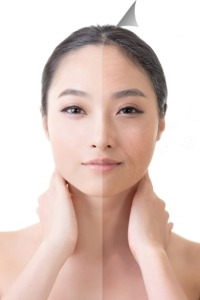As the major components of the outer skin layer are lipids, the use of lipid derivatives will enhance skin conditions. Therefore, plant oils can be used as a source of compounds that may protect skin cells due to their multidirectional activities, including anti-inflammatory, antibacterial and antioxidants, as well as the source of fatty acids. Sea buckthorn (Hippophae rhamnoides) seed oil has been traditionally used for accelerating wound healing as well as treating skin diseases.
 Due to the high content of polyphenolic compounds and vitamins, sea buckthorn extract has been found as a antimicrobial factor, with strong antioxidant activity in in vitro examinations. In Addition, sea buckthorn seed oil may reduce reactive oxygen species(ROS) levels under oxidative conditions by scavenging free radicals.
Due to the high content of polyphenolic compounds and vitamins, sea buckthorn extract has been found as a antimicrobial factor, with strong antioxidant activity in in vitro examinations. In Addition, sea buckthorn seed oil may reduce reactive oxygen species(ROS) levels under oxidative conditions by scavenging free radicals.
Many studies show the effectiveness of the antioxidant actions of sea buckthorn oil in relation to the oxidative conditions found in skin cells exposed to UV radiation. However, in physiological conditions it is not so unambiguous, because by increasing the activity of cytosolic enzymes such as NADPH oxidase and xanthine oxidase sea buckthorn oil contributes to the intensification of ROS generation. After UV radiation, sea buckthorn oil promotes reduction of the above enzyme activity and consequently ROS generation in fibroblasts. This may be the result of a stronger fibroblast susceptibility to external factors including oxidative factors such as UVA and UVB radiation and for antioxidative factors in oils.
Independent of modifications of prooxidative conditions, sea buckthorn oil promotes increases in antioxidant enzyme activity and non-enzymatic antioxidant levels in control cells as well as cells treated with UV irradiation. Results of studies partially confirm earlier observations that sea buckthorn oil may lead to enhanced antioxidant abilities by promotion of glutathione accumulation in the whole animal body in the case of rats treated with sea buckthorn oil. It was also exhibited that supplementation of rats with compounds of sea buckthorn extracts activate the enzymes superoxide dismutase, catalase, glutathione peroxidase, glutathione reductase and glutathione S-transferase in animal blood.
However, in this study sea buckthorn oil shows the tendency to decrease fibroblast Cu, Zn-SOD activity in control and UV-irradiated cells. This may be the ability of sea buckthorn oil to capture electrons and extinguish the singlet oxygen or superoxide anion that is the main substrate of SOD in cell cytoplasm. Another important cellular redox regulator is the thioredoxin system consisting of thioredoxin and thioredoxin reductase (TrxR). This expression is diminished in skin cells after UV irradiation and enhanced after sea buckthorn oil treatment of keratinocytes and fibroblasts.
This may be the ability of sea buckthorn oil to capture electrons and extinguish the singlet oxygen or superoxide anion that is the main substrate of SOD in cell cytoplasm. Another important cellular redox regulator is the thioredoxin system consisting of thioredoxin and thioredoxin reductase (TrxR). This expression is diminished in skin cells after UV irradiation and enhanced after sea buckthorn oil treatment of keratinocytes and fibroblasts.
Previously it has been shown that this system plays a significant role in the pathogenesis of a number of diseases, but it also participates in cellular protection against toxic compounds, which are reduced by thioredoxin or inhibited by thioredoxin reductase. It has been indicated that sea buckthorn includes high levels of proteins containing thioredoxin domains and prevents the disulfide bond formation in oxidizing environments and stabilizing the tertiary and quaternary structure of proteins.
It has also been shown that Trx and TrxR synthesis is induced after exposure to prooxidative factors, this explains the strong positive response of this system to UV irradiation, particularly in fibroblasts. Therefore, enhanced effectiveness of this system after oil treatment may explain reduction of oxidative stress in these cells.
Cellular antioxidant responses dependent on proteins is promoted by the transcription factor Nrf2 which is responsible for cytoprotective gene transcription. Under physiological conditions, cytoplasmic Nrf2 is bound to Keap1, but oxidative stress caused by UV radiation was found to diminish Keap1 expression which prevents Nrf2–Keap1–Cul3 complex formation. In addition, high levels of ROS and electrophiles such as 4-HNE may lead to the oxidation of Keap1 cysteine residues causing lack of binding and/or dissociation of Nrf2 from the complex resulting in its translocation into the nucleus. Nrf2 activation, demonstrated also as its targeted genes-HO-1 expression, leads to cellular protection against pro-oxidative conditions. Sea buckthorn oil treatment of UV irradiated skin cells acts in two ways—it supports the cellular antioxidant capacity by the activation of Nrf2. Meanwhile it affects the expression of proteins strongly related with Nrf2 activation.
The results showing enhanced phospho-Nrf2 translocation to the nucleus despite of the increased Keap1 level in cytoplasm clearly suggest that sea buckthorn oil disrupts the Nrf2–Keap1 complex formation. Moreover, sea buckthorn seed oil decreases UV-induced levels of p21 and p62, reducing the possibility of these proteins to create adducts with Nrf2 or Keap1, thus encouraging Nrf2 inhibition. Keap1 might also create adducts with small antioxidant molecules such as melatonin or GSH, what also prevents Nrf2-Keap1 binding, however, it does not lead to Keap1 degradation. Melatonin has been previously shown to be downregulated in skin cells following UV radiation, while UV-induced decrease in GSH level, what is shown in this study is significantly enhanced as a result of sea buckthorn oil treatment. These modifications to the activators and inhibitors of the Nrf2 pathway are not able to cancel the protective effect of sea buckthorn oil to counteract prooxidative conditions.

Leave A Comment